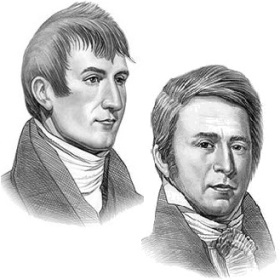|
•4. The
fruit, which, though rather larger, resembles in shape the black
haw, is a light brown berry, the fruit of a tree about the size,
shape, and appearance in every respect, of that of the United
States, called the wild crab-apple. The leaf is also precisely
the same, as also the bark in texture and color. The berries
grow in clumps at the end of the small branches; each berry
supported by a separate stem, and as many as from three to eighteen
or twenty in a clump: the berry is ovate, with one of its extremities
attached to a peduncle, where it is to a small degree concave,
the wood of which is excessively hard. The natives make their
wedges of this wood, in splitting their boards, their firewood,
and in hollowing out their canoes; the wedge when driven into
solid dry pine, receives not the slightest injury: Our party
made use of it likewise for wedges and axe-handles. The fruit
is exceedingly acid, and resembles the flavor of the wild crab.
The pericarp of the berry contains a soft pulpy substance, divided
into four cells, each containing a single seed; the outer coat
of the pericarp, is a thin smooth though firm and tough pellicle.The
plant called sacacommis by the Canadian traders, derives its
name from this circumstance: that the clerks of the trading
companies are generally very fond of smoking its leaves, which
they carry about with them in a small bag. It grows generally
in an open piny woodland country, or on its borders. We found
this berry in the prairies bordering on the Rocky mountains,
or in the more open woodlands. It is indiscriminately the growth
of a very rich or a very poor soil, and is found in the same
abundance in both. The natives on the western side of the Rocky
mountains are very fond of this berry, although to us it was
a very tasteless and insipid fruit: the shrub is an evergreen,
and retains its verdure in the same perfection the whole season
round. However inclement the climate, the root puts forth a
great number of stems which separate near the surface of the
ground, each stem from the size of a small quill to that of
a man's finger: these are much branched, the branches forming
an acute angle with the stem, and all more properly procumbent
than creeping: although it sometimes puts forth radicles from
the stems and branches, which strike obliquely into the ground:
these radicles are by no means general or equable in their distances
from each other, nor do they appear calculated to furnish nutriment
to the plant: the bark is formed of several layers of a smooth,
thin, brittle and reddish substance easily separated from the
stem: the leaves with respect to their position are scattered,
yet closely arranged, and particularly near the extremities
of the twigs: the leaf is about three fourths of an inch in
length; oval, pointed and obtuse; of a deep green, slightly
grooved; and the footstalk is of proportionable length: the
berry is attached in an irregular manner to the small boughs
among the leaves, and always supported by separate, small and
short peduncles: the insertion produces a slight concavity in
the berry, while its opposite side is slightly convex. The outer
coat of the pericarp is a thin, firm, tough pellicle: the inner
coat consists of a dry, mealy powder, of a yellowish white color,
enveloping from four to six large, light, brown seeds: the color
of the fruit is a fine scarlet: the natives eat these berries
without any preparation: the fruit ripens in September, and
remains on the bushes all winter unaffected by the frost: they
are sometimes gathered and hung in the lodges in bags, where
they are dried without further trouble.
•6. The deep purple berry, like the huckleberry, terminates
bluntly, and has a cap or cover at the end: the berries are
attached separately to the sides of the boughs by a short stem,
hanging underneath and they often grow very near each other,
on the same bough: the berry separates very easily from the
stem; the leaves adhere closely: the shrub rises to the height
of six or eight feet, and sometimes grows on high lands, but
more frequently on low marshy grounds: the shrub is an evergreen,
and about ten inches in circumference, divides into many irregular
branches, and seldom more than one stem springs from one root,
although they associate very thickly: the bark is somewhat rough
and of a reddish brown color: the wood is very hard: the leaves
are alternate and attached by a short footstalk to the horizontal
sides of the boughs: the form is a long oval, rather more acute
towards the apex than at the point of insertion: its margin
slightly serrate, its sides collapsing, thick, firm, smooth
and glossy: the under surface is of a pale or whitish green,
and the upper of a fine deep green. This beautiful shrub retains
its verdure throughout the year, and is more peculiarly beautiful
in winter. The natives sometimes eat the berries without preparation:
sometimes they dry them in the sun, and at others in their sweating
kilns: they very frequently pound them, and bake them in large
loaves, weighing from ten to fifteen pounds: the bread keeps
very well for one season, and retains its juices better by this
mode of preparation than any other: this bread when broken is
stirred in cold water, until it acquires the consistency of
soup, and then eaten.
Accounts of the Plants
Accounts of the Trees
Accounts of the Shrubs
and Undergrowth
|

